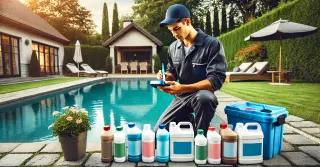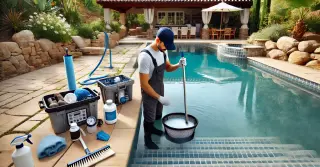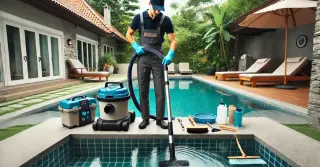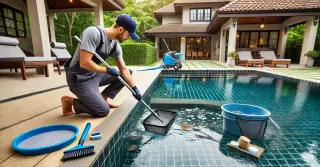Pool Chemical Balance Pensacola FL

Keeping your pool's chemical balance in check is essential for a safe and enjoyable swimming experience. Correct chemical levels stop algae and bacteria growth, ensure clear water and protect pool surfaces and equipment.
- Maintaining Proper pH: Your pool's pH level reflects its acidity or alkalinity. The ideal pH range is between 7.2 and 7.6. If the pH is too low, the water becomes acidic, which can cause skin irritation and corrosion of pool equipment. High pH levels make the water alkaline, leading to cloudiness and scaling. Consistently testing and adjusting pH levels is essential to maintain a comfortable and safe swimming environment.
- Managing Chlorine Concentration: Chlorine is a key component in pool sanitation, destroying bacteria, algae, and other harmful pathogens. The ideal chlorine level should be between 1-3 ppm (parts per million). Low chlorine levels cause unsanitary water, with bacteria and algae proliferating. High chlorine levels result in skin and eye irritation and cause a strong chlorine smell. Consistently monitoring and adjusting chlorine levels ensures sanitation and comfort.
Optimal Alkalinity LevelsTotal alkalinity is another critical aspect of pool water chemistry. Alkalinity stabilizes pH levels, preventing drastic pH fluctuations. The optimal total alkalinity range is 80-120 ppm.
- Preventing pH Swings: Correct alkalinity levels ensure stable pH, preventing rapid changes that can cause skin irritation and damage to pool surfaces. Low alkalinity causes pH levels to fluctuate, making consistent balance difficult. Excessive alkalinity results in cloudy water and scaling. Regularly testing and adjusting alkalinity levels is crucial for stable and balanced water.
- Balancing Calcium Levels: Calcium hardness indicates the calcium level in pool water. Optimal calcium hardness levels are between 200-400 ppm. Insufficient calcium causes corrosive water, damaging surfaces and equipment. If calcium levels are too high, it can cause scaling on pool surfaces and cloud the water. Regularly testing and adjusting calcium hardness is crucial for safeguarding your pool and maintaining clear water.
Using Pool Chemicals SafelyUsing and storing pool chemicals safely is vital for safety and chemical performance. Store chemicals in a cool, dry place, away from direct sunlight, children, and pets. Always follow the manufacturer's instructions for proper dosing and application.
- Measuring and Mixing Chemicals: Measuring pool chemicals accurately is crucial for maintaining balance. Inaccurate dosing can imbalance chemicals and harm water quality. Always use a clean, dry measuring cup or scoop and never mix chemicals directly with each other. Mix in water as needed, following guidelines carefully.
- Awareness of Chemical Reactions: Some chemicals can react dangerously when combined. For example, chlorine and acid should never be mixed. Being aware of these interactions helps prevent accidents and ensures safe handling. Store chemicals apart and handle each carefully to avoid dangerous reactions.
Ensuring the right chemical balance in your pool is essential for a safe, clean, and enjoyable swimming environment. By frequently testing and balancing pH, chlorine, alkalinity, and calcium, you ensure optimal water quality.
Proper chemical use and storage further ensure the health and safety of your pool and its users.




